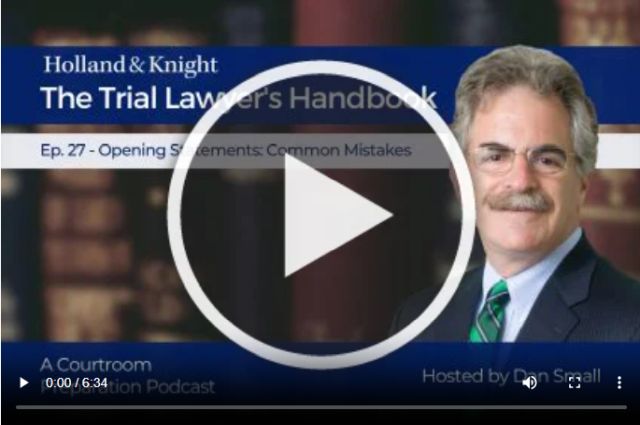In this episode of his "The Trial Lawyer's Handbook" podcast series, litigation attorney Dan Small discusses some common mistakes that lawyers tend to make in opening statements. He explains that although there's no such thing as a perfect trial – or anything close to it – some mistakes are easier to avoid than others.
Listen and subscribe on Amazon.
Listen and subscribe on Apple Podcasts.
Listen and subscribe on SoundCloud.
Listen and subscribe on Spotify.
Watch and subscribe on YouTube.
Mr. Small is also the author of the new American Bar Association (ABA) book Lessons Learned from a Life on Trial: Landmark Cases from a Veteran Litigator and what They Can Teach Trial Lawyers.
Podcast Transcript
Dan Small: There's no such thing as a perfect trial. Nor should there be. It's not a perfect world, and jurors do not want robots talking to them. They will tolerate, and in some ways even appreciate, minor mistakes. They know that they would make them if they were standing up in your shoes. Beyond that, some mistakes are easier to avoid than others. Here are some common mistakes that lawyers make in opening statements.
First, not starting at the beginning. Jurors tend to feel overwhelmed at the beginning of a trial, particularly in complex cases. Information and new experiences are coming at them from all angles, and they often feel disoriented and confused. The first order of business is to orient them and orient them in the right way. Tell them who's who and what's what. Who the parties are, what kind of case it is, what the dispute is about, and so on. Plunging right into the evidence without any setup is risky at best.
The second mistake: Using a witness-by-witness recitation of the evidence. There are several basic ways to organize your opening statement. The most basic is a chronological description, but one common method lawyers use is to organize it by witnesses. It's the lazy way out. Don't do it. "You will hear from Mary Jones, the executive vice president for human resources. She will tell you blah, blah, blah, blah, blah. You will hear then from Joe Smith, the deputy superintendent for shipping and receiving. He will tell you blah, blah, blah, blah" and so on. For God's sakes, don't do it. That's not how you would communicate. That's not how you would tell a story in the real world. It's not a good idea. In an opening statement, an inherent flaw in the trial process is that the evidence comes in witness by witness in a disjointed fashion. You can't change that. But why would you organize your opening in the same disjointed way?
Third mistake: Reciting unnecessary detail. The opening statement is normally the first time that the jury learns very much about the case. For that reason, it's the worst possible time to load up on unnecessary detail.
Eliminate every single detail from your opening statement that isn't necessary to tell the story or to make a point. Certain details like dates, times and addresses are particularly problematic. They're not merely superfluous. They're like lead weights weighing down your opening statement. Compare these two approaches:
This: At the bi-monthly Human Resources staff meeting on August 16, 2014, the Executive Vice President for Human Resources, Mary Jones, spoke with the Midwest Regional Personnel Director about a potential transfer of the plaintiff to the South Central Regional Sales and Marketing Office, which is located in Wichita, Kansas.
Or this: In the summer of 2014, her supervisors discussed transferring her to Kansas.
Of course, some details help to paint a picture or propel the story forward. An opening with no detail would be flat and uninteresting. But if it doesn't matter or it doesn't help, take it out.
Fourth mistake: Not using visual aids. Visual aids should be an integral part of any opening statement. Let's take a simple automobile accident. An obvious visual aid would be a diagram of where the accident occurred. An ordinary juror would surely find that helpful. There it is, right in front of them, and it can be created or even downloaded easily on your computer. What about a timeline or other Simple but clear graphics?
Fifth mistake: Stating "What I say is not evidence." What? Of course it's true. But why say it? Most jurors won't even understand what it means. Does it mean he doesn't know what he's talking about? And it suggests that they shouldn't give too much credence to whatever you have to say. Let the judge say it if he has to, but not you.
Number six: Making risky promises. Be very careful about making promises that you can't keep. If you promise that something will come in and it doesn't, you'll hear about it later. And you will not enjoy it when that happens. If there's any doubt about whether you'll be able to prove something, leave it out. Make it a nice surprise later on.
Number seven mistake: Reading a script. Openings are very dangerously susceptible to being read aloud in a stilted or wooden manner, and this is probably because lawyers tend to prepare their openings more carefully than their examinations or closings, and because they're more likely to be nervous at that point of the trial. It's fine to be nervous, but scripting is not the answer. Script your opening carefully if that helps, but deliver it. Don't read it. None of us like being read to by a stranger.
You'll make plenty of mistakes at trial. All lawyers do, and that's fine. But that's not an excuse for being boring or confusing in your opening. Don't be.
The content of this article is intended to provide a general guide to the subject matter. Specialist advice should be sought about your specific circumstances.

